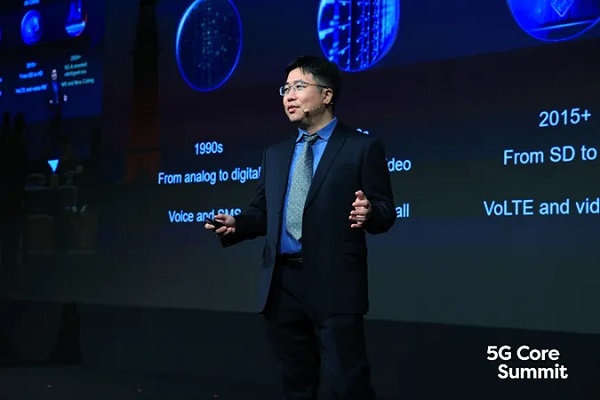At the 9th 5G Core Summit in Dubai, UAE, held from September 10 to 11, 2024, Mr. Chen Haiyong, President of the CS&IMS Domain of the Huawei Cloud Core Network Product Line, delivered a keynote speech on the evolution of voice networks in the 5G-Advanced (5G-A) era. He highlighted Huawei's commitment to empowering operators by consolidating basic voice and video networks using SVX4, enhancing voice networks with intelligent calling agents, and developing New Calling into an entry for intelligent services.

Chen Haiyong delivering a keynote speech
The communications industry has undergone a transformative evolution, shifting from analog to digital, from TDM to IP, and ultimately to an all-cloud architecture. As a fundamental component of communication services, calling is experiencing significant transformation, becoming increasingly personalized, intelligent, and platform-like. With the advent of the 5G-A era, this trend is particularly pronounced, accelerating the voice industry's transition to an intelligence-driven era. Consequently, new opportunities are emerging for operators to drive business success and capitalize on the latest innovations.
Elevating the Value of Calling with VC and DC
Leading operators are driving the widespread commercial adoption of New Calling services, transforming the traditional calling experience by integrating basic services with cutting-edge features such as high-definition (HD) quality, intelligence, and interactivity. By leveraging the Video Channel (VC), they are revolutionizing voice-only calls into immersive video experiences, complete with personalized features like AIGC avatars, real-time translation, fun calling, and voice-driven avatars. This not only elevates user experiences but also unlocks new revenue streams through content creation and monetization. Meanwhile, the Data Channel (DC) is enabling operators to redefine enterprise-oriented calling services, allowing enterprises to interact with customers more efficiently and conveniently. For instance, customer service hotlines have been upgraded from the traditional DTMF-based, key-controlled interactions to DC-based, touch-screen interactions, making it easier for enterprises to close transactions during calls, such as reservations and remote assistance, and expand their B2B market reach.
As highlighted by Mr. Chen Haiyong, Chinese operators are at the forefront of deploying New Calling, with tens of millions of users already on board. Globally, operators in Europe, the Middle East, Southeast Asia, and Latin America are also actively deploying or testing New Calling services, with plans to launch commercial services by the year end.
Seizing Service Entries with Intelligent Calling Agents
The calling industry is on the brink of a revolution, with terminal vendors, OTT players, and operators all striving to drive innovation. Leading operators are leveraging terminal-network-cloud synergy to secure entries for intelligent services. According to Mr. Chen Haiyong, operators possess a distinct advantage in this space, boasting app-free services, inclusive terminals, and real-time capabilities that can create seamless user experiences. This unique combination positions operators to develop users' dialers into entries for intelligent services.
Huawei is dedicated to empowering operators to create dialer-based intelligent agents, leveraging foundation models to enhance users' calling experiences and capitalize on entries for intelligent services in the 5G-A era. According to Mr. Chen Haiyong, Huawei has assisted operators in consolidating calling entries through three key functions: Intelligent Call Proxy, which answers calls on behalf of users; Intelligent Call Pilot, which offers real-time assistance during calls; and Intelligent Call Partner, which accompanies users throughout the call process. These innovations have significantly improved user experience and efficiency. Additionally, Huawei has helped operators seize application entries with the power of AIGC. For example, AIGC-based digital characters for customer services can engage with customers efficiently using natural language interactions, reducing costs and enhancing efficiency for enterprises, while expanding operators' B2B market presence. Building on these advancements, Huawei aims to enable operators to offer personalized intelligent assistants to each user and establish a unified entry for calling applications.
Building a Solid 5G-A Fundamental Voice and Video Network with SVX4
Commercial success is a marathon, not a sprint. It requires a sustained effort to build a robust network, attract and retain users, and create new revenue streams through innovative services. For New Calling to achieve its goals, a solid foundation is essential — a robust 5G-A fundamental voice and video network. To strengthen this foundation, Huawei proposes the SVX4 scheme, a comprehensive solution comprising four key solutions: Single Voice Core (SVC), Single Voice Insight (SVI), Single Voice Roaming (SVR), and Single Voice Escape (SVE). SVC addresses the EOX issues of 2G and 3G core network devices, connecting fixed and 2G-to-5G mobile users to the same voice network. SVI elevates network quality, delivering an exceptional experience with a MOS of 4.0 across the board, while also driving increased VoLTE user adoption. SVR enables seamless VoLTE roaming, without disrupting existing CS roaming settlement processes. Finally, SVE empowers operators to build ultra-reliable networks that mitigate the risks of network disconnection, ensuring a superior user experience.
In his closing remarks, Mr. Chen Haiyong emphasized the crucial role of industry-wide collaboration in advancing global video call interworking and roaming, as well as developing the New Calling industry ecosystem. He urged all stakeholders, including device vendors, network operators, and service providers, to embrace openness and cooperation to foster innovation and drive service intelligence. By working together, we can unlock the full potential of the New Calling industry and ensure a bright future for all involved.

